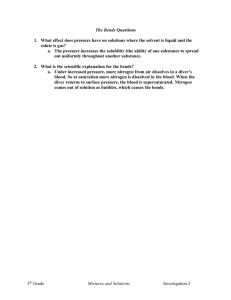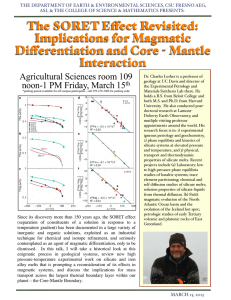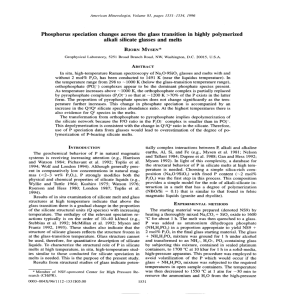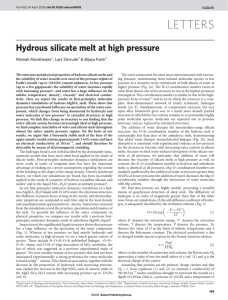Speciation and solubility of nitrogen in silicate melts at high pressure
advertisement
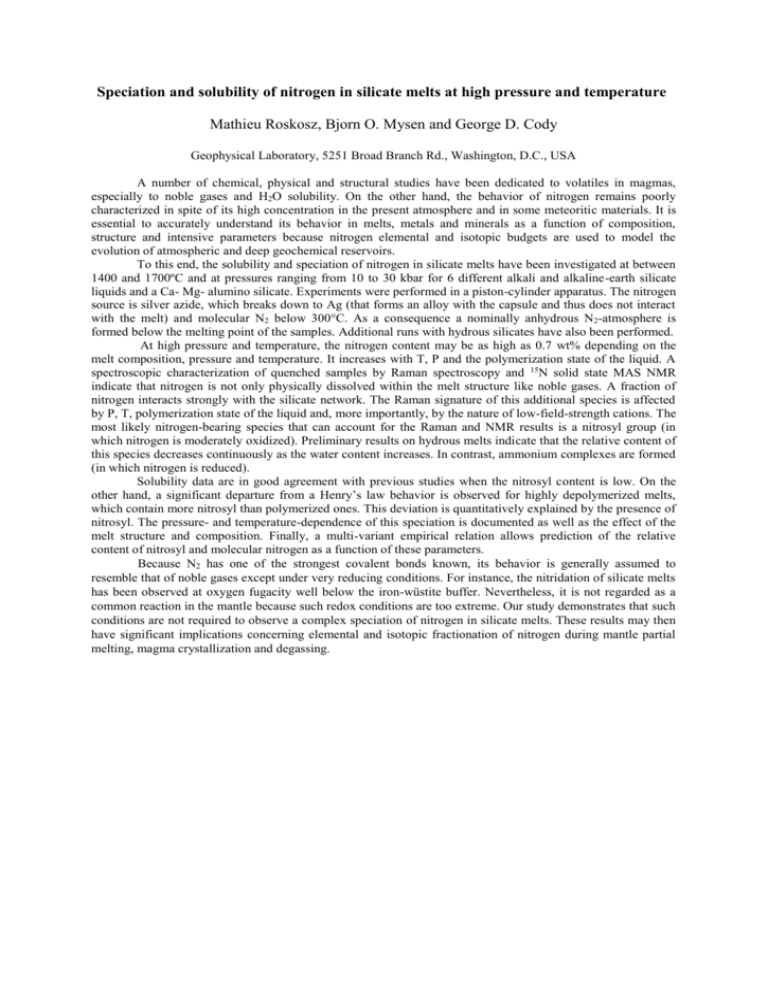
Speciation and solubility of nitrogen in silicate melts at high pressure and temperature Mathieu Roskosz, Bjorn O. Mysen and George D. Cody Geophysical Laboratory, 5251 Broad Branch Rd., Washington, D.C., USA A number of chemical, physical and structural studies have been dedicated to volatiles in magmas, especially to noble gases and H2O solubility. On the other hand, the behavior of nitrogen remains poorly characterized in spite of its high concentration in the present atmosphere and in some meteoritic materials. It is essential to accurately understand its behavior in melts, metals and minerals as a function of composition, structure and intensive parameters because nitrogen elemental and isotopic budgets are used to model the evolution of atmospheric and deep geochemical reservoirs. To this end, the solubility and speciation of nitrogen in silicate melts have been investigated at between 1400 and 1700ºC and at pressures ranging from 10 to 30 kbar for 6 different alkali and alkaline-earth silicate liquids and a Ca- Mg- alumino silicate. Experiments were performed in a piston-cylinder apparatus. The nitrogen source is silver azide, which breaks down to Ag (that forms an alloy with the capsule and thus does not interact with the melt) and molecular N2 below 300°C. As a consequence a nominally anhydrous N2-atmosphere is formed below the melting point of the samples. Additional runs with hydrous silicates have also been performed. At high pressure and temperature, the nitrogen content may be as high as 0.7 wt% depending on the melt composition, pressure and temperature. It increases with T, P and the polymerization state of the liquid. A spectroscopic characterization of quenched samples by Raman spectroscopy and 15N solid state MAS NMR indicate that nitrogen is not only physically dissolved within the melt structure like noble gases. A fraction of nitrogen interacts strongly with the silicate network. The Raman signature of this additional species is affected by P, T, polymerization state of the liquid and, more importantly, by the nature of low-field-strength cations. The most likely nitrogen-bearing species that can account for the Raman and NMR results is a nitrosyl group (in which nitrogen is moderately oxidized). Preliminary results on hydrous melts indicate that the relative content of this species decreases continuously as the water content increases. In contrast, ammonium complexes are formed (in which nitrogen is reduced). Solubility data are in good agreement with previous studies when the nitrosyl content is low. On the other hand, a significant departure from a Henry’s law behavior is observed for highly depolymerized melts, which contain more nitrosyl than polymerized ones. This deviation is quantitatively explained by the presence of nitrosyl. The pressure- and temperature-dependence of this speciation is documented as well as the effect of the melt structure and composition. Finally, a multi-variant empirical relation allows prediction of the relative content of nitrosyl and molecular nitrogen as a function of these parameters. Because N2 has one of the strongest covalent bonds known, its behavior is generally assumed to resemble that of noble gases except under very reducing conditions. For instance, the nitridation of silicate melts has been observed at oxygen fugacity well below the iron-wüstite buffer. Nevertheless, it is not regarded as a common reaction in the mantle because such redox conditions are too extreme. Our study demonstrates that such conditions are not required to observe a complex speciation of nitrogen in silicate melts. These results may then have significant implications concerning elemental and isotopic fractionation of nitrogen during mantle partial melting, magma crystallization and degassing.
